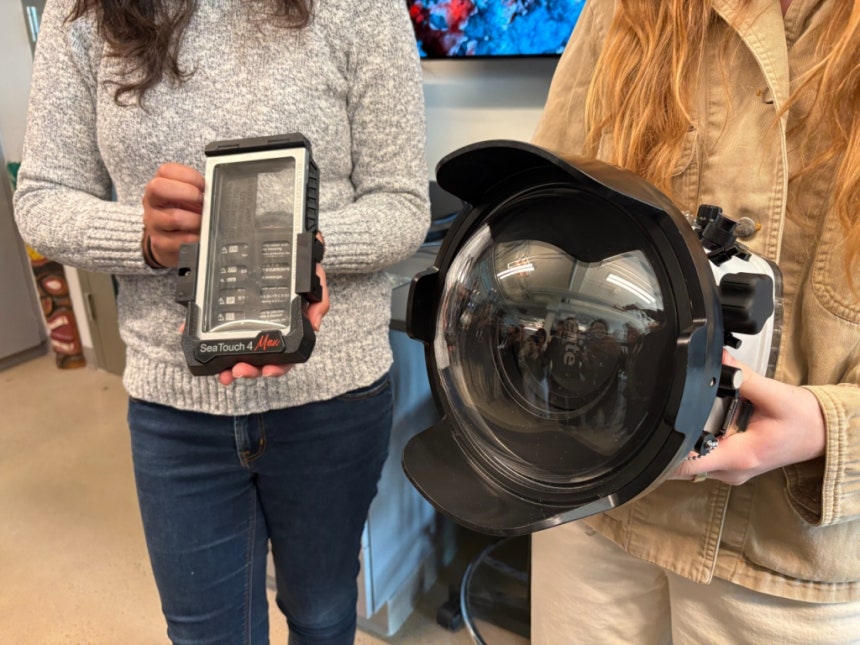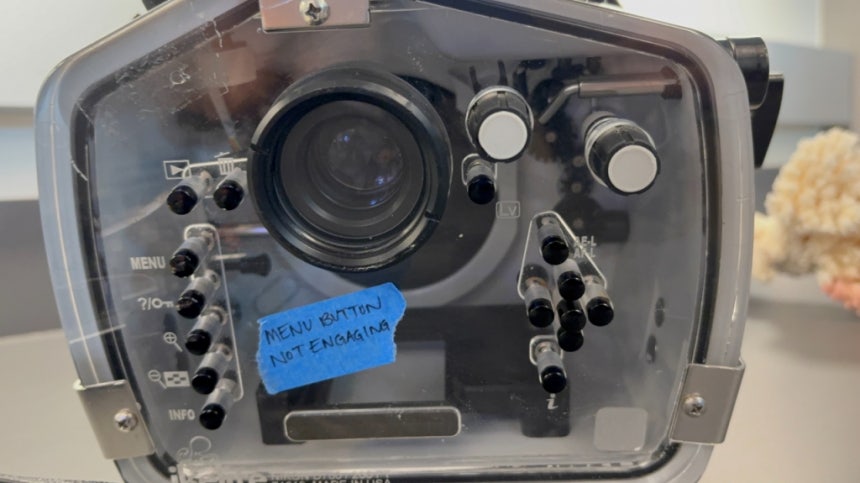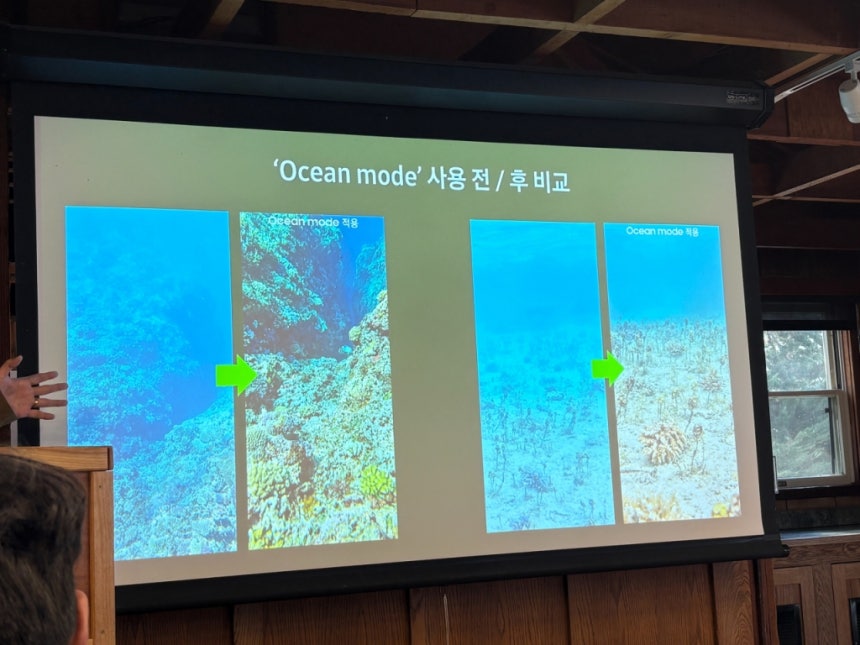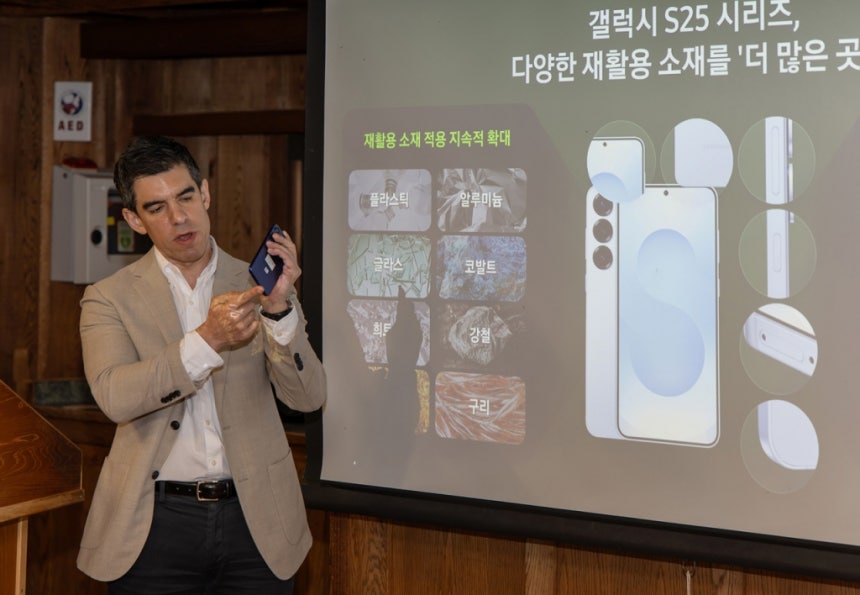[Galaxy Unpacked 2025] Supporting Global Coral Reef Restoration with Galaxy Smartphones
Collaborating with UCSD… Subaquatic photography without DSLR is OK
Recycled materials applied to Galaxy S25 series parts… Establishing an eco-friendly circulation system,

Personnel from the Scripps Institute of Oceanography at UC San Diego (UCSD) showcase the photography equipment used in the coral reef restoration project. The right shows the previous equipment using a DSLR, and the left shows the current device using the Galaxy S24 Ultra, highlighting the clear difference in size. /Photo by Bae Hannim,
, ‘”We are conducting projects on 100 islands around the world for coral reef restoration. While places like Florida in the U.S. are included, many involve islands in the Caribbean and Southeast Asia like Bali and Fiji. Many of these communities prefer Galaxy devices, leading to our collaboration with Samsung, especially for Galaxy’s extensive global reach.” ‘,
,
, “Leah Hays, Project Director at the American non-profit organization Seatrees, explained the utilization of the Galaxy S24 Ultra in the ‘Coral in Focus’ project, attributing the choice to Galaxy being the most widely used smartphone globally. “,
,
, “This project involves capturing underwater photos of coral reefs in major habitats currently undergoing severe destruction using Galaxy smartphones to monitor and restore their condition. Tens of thousands of photos taken by Seatrees are used in producing and researching 3D coral reef restorations at UCSD’s Scripps Institute of Oceanography. These photos serve as crucial data for informing governments, research institutions, and the public worldwide of the importance of coral reef restoration. Therefore, it’s essential to regularly capture as many photos as possible with the help of local residents. “,
,
, “Professor Stuart Sandin of Scripps explained, ‘Securing large volumes of high-quality photo data is crucial for coral reef research. Initially, we collaborated with major camera companies, but there were many limitations with using cameras for capturing, storing, managing, transferring, and utilizing underwater photos. Working with mobile devices allowed for maintaining photo quality while increasing ease of capturing, enabling us to take more photos.’ “,
,
, ‘Director Hays emphasized, “Although Seatrees and UCSD are based in the U.S., and we often get asked why we don’t collaborate with Apple’s iPhone, many regions worldwide are more familiar with Android OS and Galaxy UX/UI, which made learning to use the devices much easier.” ‘,
,
, ‘

Previously, using a DSLR required mastering complex operation methods. /Photo by Bae Hannim,
, ‘On the 24th (local time) at UCSD’s Scripps Institute in San Diego, California, the method and results of underwater shooting with the Galaxy S24 Ultra were reviewed. The equipment used for underwater photography before utilizing smartphones involved a gigantic DSLR camera seemingly straight out of a 19th-century photo studio, weighing over 3-4 kg. In contrast, the current equipment is comparable to a slightly thicker and sturdier smartphone waterproof case, slightly heavier than a smartphone itself. ‘,
,
, ‘A Scripps representative explained, “Previously, taking underwater photos with such large equipment posed not only weight and bulk issues but also required educating local activists on the complex usage of cameras and photography equipment. The use of Galaxy phones provided significant convenience, enabling simple, fast, and lightweight photography using a familiar touch screen method.” ‘,
,
, ‘

Comparison before and after using Samsung’s ‘Ocean Mode’ for accurate underwater photography. /Photo by Bae Hannim,
, “Galaxy’s camera technology has significantly contributed. With advancements in smartphone camera technology, underwater photography, previously only accurately achievable with professional equipment like DSLR, can now be done with a smartphone camera. In some regions, corals appear only blue due to deep water and light distortion issues. The coral’s color contains various information about its density, years of growth, health, and future growth potential.’ “,
,
, ‘Ye Dongwon, in charge of Camera Quality Development at Samsung Electronics MX (Mobile eXperience) Division, introduced the special ‘Ocean Mode’ feature developed for Seatrees and Scripps. ‘Ocean Mode’ adjusts white balance to capture the coral’s true colors and optimizes shutter speed to capture clear photos even in low-light underwater conditions. It also includes an interval function to take thousands of continuous photos without repeatedly pressing the shutter. Previously, such features were only possible with DSLR cameras handled by professionals. Ye explained, “Ocean Mode was specifically developed and provided as a new app for this project.” ‘,
,
, ‘

Daniel Araujo, vice president of Samsung Electronics MX division’s Sustainable Management Office, presents the Galaxy’s eco-friendly policy on the 24th (local time) at the Scripps Institute of Oceanography at UC San Diego (UCSD). /Photo by Samsung Electronics,
, ‘Meanwhile, Samsung Electronics is implementing various eco-friendly policies in addition to the Coral in Focus project. The Galaxy S25 series, unveiled on the 22nd (local time), includes △ batteries utilizing cobalt extracted from recycled Galaxy batteries △ recycling aluminum materials applied to the exterior △ recycling plastic waste used in semiconductor factories. ‘,
,
, ‘Daniel Araujo, vice president of Samsung Electronics MX division’s Sustainable Management Office, stated, “Even small changes from a company with a massive global infrastructure like Samsung Electronics can lead to significant impacts. We aim to continue Galaxy’s technological innovations from protecting the marine environment to restoring marine ecosystems.” ‘

